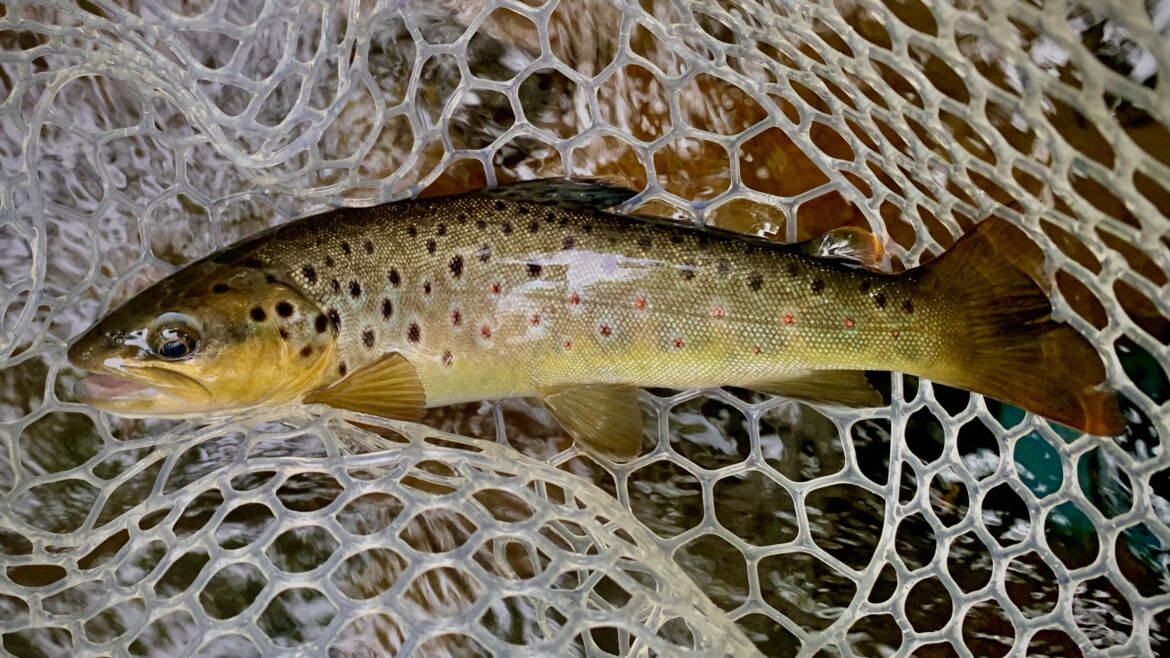Trout are a species that holds special significance for many fishermen. Their Beautiful colors and abundance across the US have cemented them as one of the best sportfish in America.
Trout are typically pretty picky eaters compared to other common fish like bass. Because of this, a good line and lure setup is essential for the best results when fishing for trout. Below, I will cover a variety of trout-specific information, from behavior to the best rigs for both spin fishermen and fly fishermen, to help you catch more fish.
Before I go deeper into the article, I would like to make a suggestion: download the Fishbox App. The app is chock full of great fishing advice and a bite prediction system that analyzes metrics to predict bite patterns. Use this to your advantage to catch more fish, and download the fishing app today.
Get your personalized fishing map
Answer a quick quiz and get your own personalized fishing map
Understanding Trout and Their Behavior
In the US, there are five main types of trout, brown trout, rainbow trout, cutthroat trout, lake trout, and brook trout; though brook trout are technically a type of char (salmon), I’ll still include them because they are often grouped with trout. On the East Coast, fishermen target brown, rainbow, and brook trout, with many of the brown trout and some rainbows exceeding twenty pounds. All the species and countless subspecies can be targeted as you head west toward bigger rivers and cooler waters.
Trout Habitat and Temperature Preferences
Trout, in general, are colorful fish that live in cool mountains or plains, creeks, rivers, and lakes. You’d be lucky to find any species of trout in water that exceeds 70 degrees, and many of these fish will not be healthy. Because of this, the time of year and temperature hugely affect where trout will be held and where they can be best targeted.
Rainbow trout are often considered the hardiest of the trout species, meaning that they can survive in the highest water temps and least pure water when compared to other trout species. Because of this, rainbow trout are the most common and targeted species of trout across the US and even the World. In rivers and creeks, rainbow trout tend to sit in faster water even if there isn’t much cover nearby. Small rainbows can be found in nearly every higher-elevation creek with fast-moving water across America. The bigger fish tend to stay near deeper pools that provide cover and sit near the head of the pool where the water is the most oxygenated or just upstream of it in the faster water.
When trout fishing, it is important not to skip any water. This is especially important on rivers and larger creeks. Trout will sit in nearly any speed of water as long as it is deep enough to allow them to swim around. I have caught trout as big as thirteen inches in water, no more than 6 inches deep. All that being said, many factors specific to your fishing area impact what rig set up should be used and how it should be fished.
Identifying Different Trout Species
Trout are some of the most colorful and marked freshwater fish, and certainly the most in the US.
- Rainbow trout are silver-gray with a pink/purple stripe down the middle. Their colors can be more subdued at times, but a colored-up rainbow has pink gill plates and a pink stripe with black dots on the back and down the sides.
- Cutthroat trout are similar to rainbows, though there are several species that all have slightly different looks. In general, you distinguish a cut from a bow by the redish-pink slash under the fish’s jaw. This feature is not always super obvious, but you’ll see it if you look just under the gill.
- Brown trout are typically yellow-bellied with a brown back and black or dark brown spots. They can be more subdued and often take on a tanner coloring.
- Lake trout are gray with a darker back, sometimes taking on a green or yellowish undertone. They are fully covered in white dots, including on the gill plates and head.
- Brook trout is typically dark, with a brown near black back and orange belly. They have a very pronounced white stripe on the front of their bottom fins and are covered with red dots surrounded by a blue halo. You will often catch brook trout with dark bars running vertically down the fish’s flank.
Essential Gear for Trout Fishing
For the most part, trout are not huge, and besides the rare outliers, in most streams and lakes, it is rare to catch fish bigger than two and a half to three pounds (about 20 inches, depending on the health of the fish). This necessitates lighter rods and lines than would typically be used for other sportfish like bass.
Rod and Line Recommendations
Spin Fishing:
- Rod: Medium-light action rod in the six-to-seven-foot range.
- Line Weight: Between 6 and 15 pounds, depending on the size of the water and rig setup.
- Line Type: Monofilament is definitely the best option, as trout are quite finicky in most places, and the more obvious braid will likely spook the bigger fish.
Fly Fishing:
- Rod and Line: For fly fishermen, the rod options are more varied as it depends on both the flies being thrown and the size of the fish being targeted:
- Fly Rods: In general, they are lighter action and better suited for using lighter lines and targeting smaller and typically wild fish.
- Weight Ratings: Fly rods are measured by weight, from 1 wt (lightest) to 12 wt and beyond (for saltwater applications).
- Recommended Setup: A 5wt fly rod with a 5wt floating line provides versatility for varying fly sizes and fish targets.
Get your personalized fishing map
Answer a quick quiz and get your own personalized fishing map
Wading Gear
Fishing for trout often requires wading in the river, stream, or lake. This allows you to position yourself better so the fish can’t see you, and so you can cast your lure or fly into the best water. Trout waters are cold, though, and often quite fast-moving, which means that waders are often necessary to safely and comfortably wade.
- Winter, fall, and spring: I often see myself reaching for my waders as the combination of colder air and frigid water is not comfortable to fish in. In such conditions, waders and a coat are extremely nice to have, as standing in the water cools your body off significantly.
- Summer: More forgiving as temps are high, and the water can often be quite comfortable. In the summer, I typically fish with just my pair of wading boots (felt soles grip rocks a bit better than a typical shoe) and a regular pair of socks.
Fishing for Trout in Rainy Conditions
Rain year-round has typically been good for fishing for me, so I don’t shy away from fishing during these times. It requires a good raincoat and waders, but if you expect to get a little wet, it’s still possible to have a great day of fishing; another point is to watch for quickly rising water, especially in the mountain drainage trout inhabit.
Trout Rig Components/Setting Up a Trout Fishing Rig
Trout typically feeds on small bugs on top or under the water; these make up the majority of even the biggest fish’s diets. Because of this, fly fishing is the most common and popular way to fish for trout in the East and West.
Fly Fishing Rig Setup
Fly fishing trout rigs, for those unfamiliar, seem quite weird compared to a standard spinning rig. At the end of the fly line, a leader is attached either by a knot or a loop-to-loop connection. This leader isn’t just a straight piece of monofilament but a tapered line that goes down to a much thinner portion of what is called a tippet (mono or fluorocarbon leader). The leader is about the length of the rod, so for a standard nine-foot rod, the leader will also be nine feet, which includes about three to four feet of taper and about five feet of straight tippet.
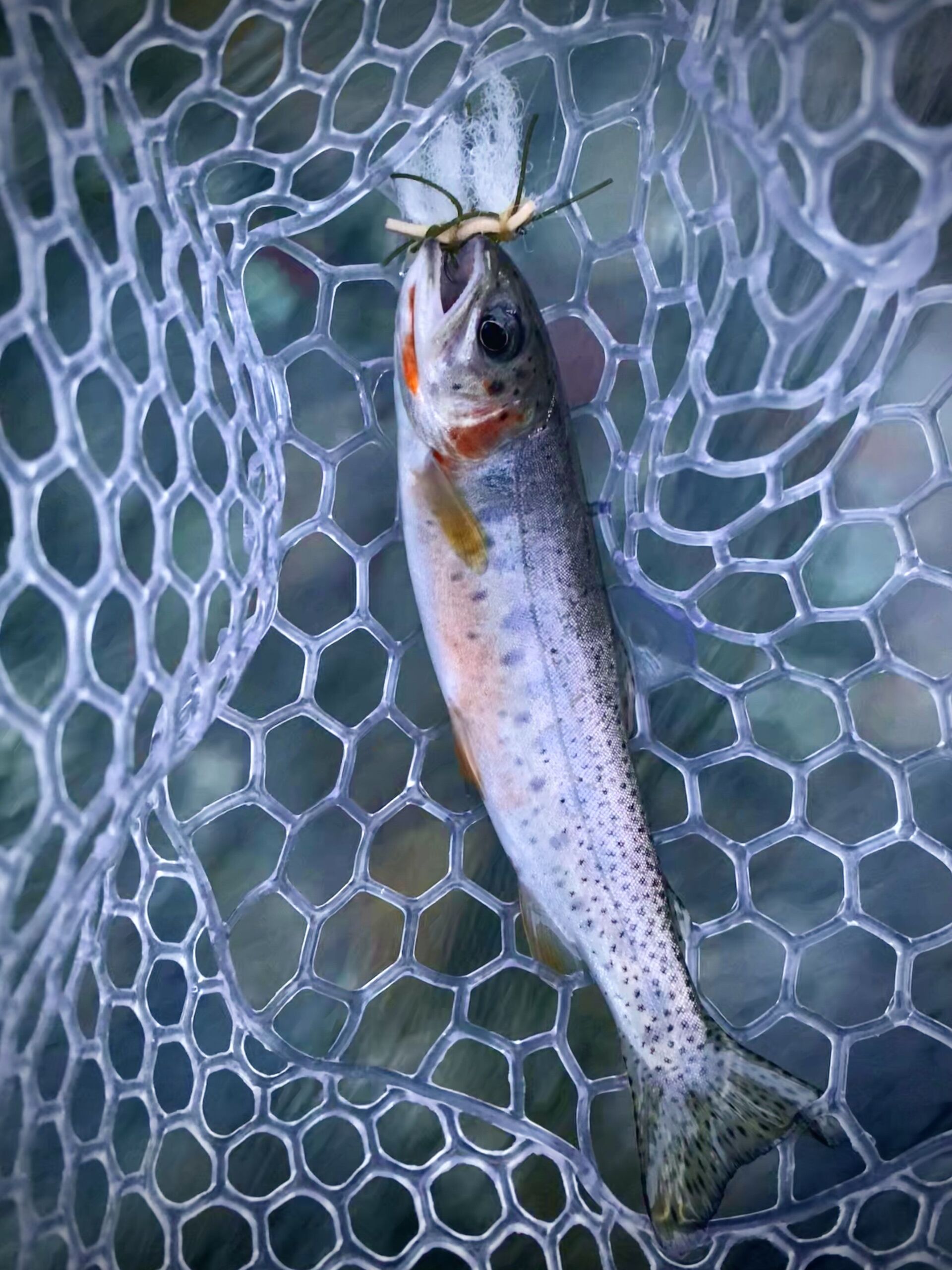
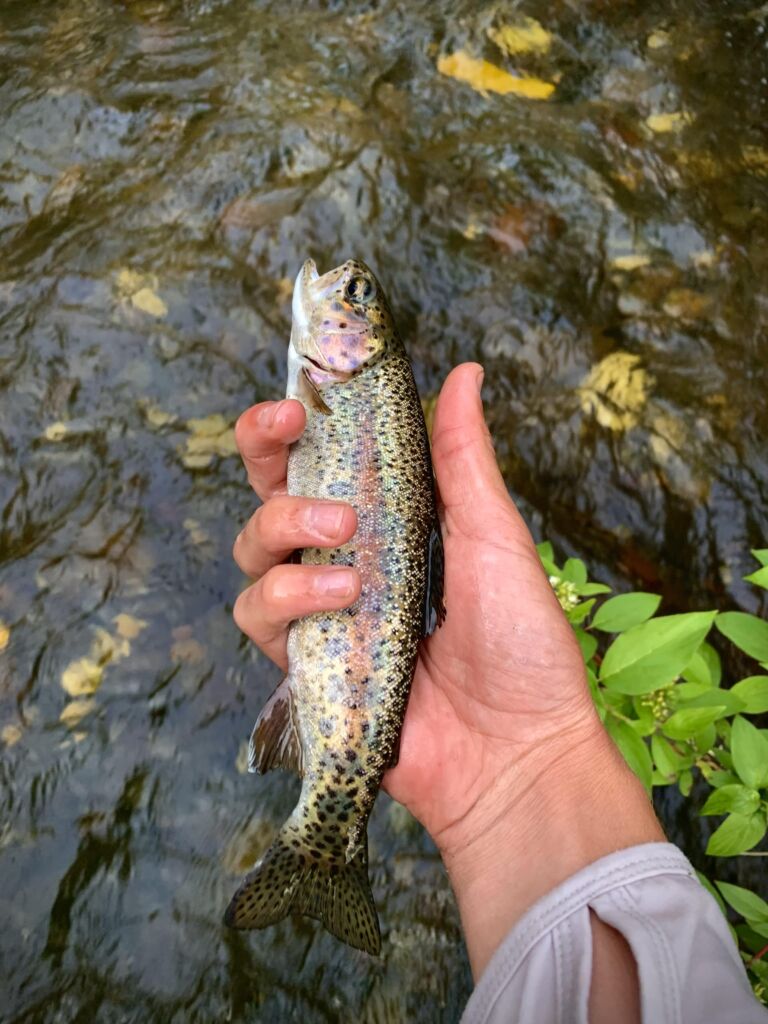
Tippet Sizes
For different-sized fish, water clarities, and fishing pressure in the area, different sizes of tippets are needed. For a small clear creek that receives a decent amount of pressure, 6x or 7x tippet (the smallest sizes) is required, but in a muddied river or when fishing for larger fish, 3x or 4x is probably your best bet. There are thousands of fly patterns to put on the end of your leader, I recommend using a simple improved clinch knot. A trout is unlikely to refuse a fly because of the pattern you choose, as long as it looks somewhat close to the bugs on top of or under the water, you’ll be fine.
Fly Fishing Rig Types
There are several ways to set up fly fishing rigs for distinct types of water, for nearly all water types, a rig called the dry dropper is lethal. This is a two-fly rig with a big dry fly (one that floats on top of the water) acting as a bobber for a nymph (smaller underwater larva). I like to tie my dry fly to the end of the leader and use a smaller tippet to connect the dropper below. For the most part, I use about sixteen inches of tippet below the dry fly so that it can be fished in the widest variety of depths. This is something that has to be gauged based on the size of the water, general wisdom says to make your second piece of tippet about 1.25-1.5 times the depth of the water. I have had about as much luck running it in the 0.8-1 times range, and it helps to avoid snags.
Other options for fly fishing rigs are a simple dry fly rig or a double dry rig, which is similar in setup to the dry dropper but with two dry flies. This is better for water that has lots of bug life above the water. An indicator rig is one of the best options for beginner fly fishermen as it is easy to read when the fly has been taken. This is just a bobber rig with a fly a few feet below a “strike indicator,” again, the same 1.25-1.5 times water depth applies for how far below the bobber the flies should be suspended. My favorite setup for flies when fishing an indicator rig is to have a larger wet fly, typically referred to as an anchor fly, 6 to 10 inches above the main fly. I’ll use a large, heavy stonefly pattern for these setups, followed by something smaller like a pheasant tail or hare’s ear nymph. At the very least, the heavier, larger fly will help keep the rig closer to the bottom, but I think it kind of acts as an attractor, and even if the fish don’t hit it, they will often take the trailing fly.
Spin Fishing for Trout
While my preferred method, fly fishing, is not the only way, or even sometimes the best, to target trout. There are several spin fishing rig set ups for trout that are very effective for catching trout. My go rig on a spinning rod is a simple in-line spinner, and it is one of the most effective ways to catch especially stocked trout. This is probably the easiest way to fish for trout as well; there is virtually no special gear required, just your line straight to the lure, though do make sure the two or three feet in front of the spinner are mono, or you risk spooking fish.
Bait Fishing for Trout
Bait rigs for trout are less common than artificial ones but not less effective if you fish them the right way. A bobber rig with worms can catch trout in any body of water and sometimes get them when nothing else is doing the trick. Power bait, corn, and salmon eggs are other popular baits that can either be floated below a bobber or suspended from the bottom.
My recommendations depending on the type of body of water:
- Lakes/Ponds: Use a Carolina-style rig with a weight, swivel, about eighteen inches of line, and the hook. This will allow you to suspend the bait off the bottom, as trout don’t tend to eat off the bottom.
- Rivers/Streams: Float bait below a bobber a foot and a half or so, again depending on water depth, this will keep the bait in the trout’s strike zone for the longest period of time.

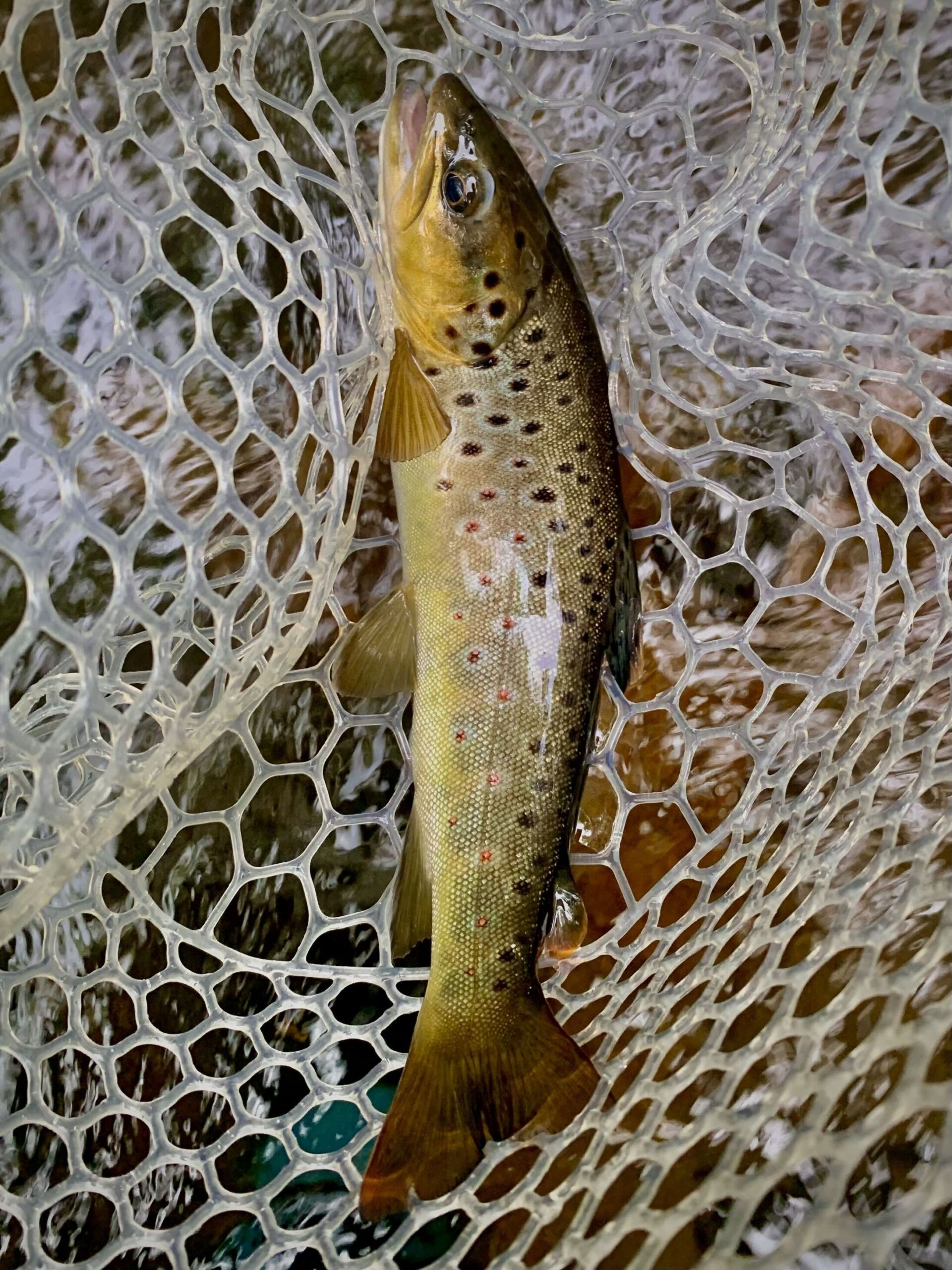
Where to Look for Trout
The most difficult part of trout fishing is figuring out where the fish sit in the lake, river, or stream. As I said before, in smaller streams especially, trout will sit in virtually every place they can, including the long five-inch-deep rifle runs and the fast whitewater sections. I like to target every section of the river I can with at least a cast or two just in case there is a fish there. Trout do prefer specific areas of the river, and this actually depends on the species of trout they are.
Read also: How to Fish for Trout in a River: Proven Tips and Techniques
Trout Species and Their Preferred Habitats
- Rainbow trout tend to be in faster water than brown trout and brook trout. Though they can be found in any area of the stream, the larger ones will sit in fast runs below whitewater and even in it. The section of a pool right below a waterfall or weir will almost certainly provide a rainbow.
- Brown trout, unlike rainbows, tend to be in the slower pools by big logjams or brush piles. If you find a deep pool three plus feet deep, it is almost guaranteed to hold a big brown trout if the water below allows access. Brown trout also like murkier water, not to say that the others won’t be found in clouded water, but browns tend to be more aggressive and numerous in streams with some cloudiness in the water. Cut-banks or overhanging banks are also great brown trout water. This is where the moving water has eroded away much of the bank, leaving it overhanging the water, allowing great cover and not impeding the flow of food to the fish.
- Cutthroat trout are a bit of an everywhere fish in my experience, though it seems to me they favor smaller creeks over wide rivers, I have caught them out of just about every type of water at about the same rate as other species. However, one thing to note is that in many drainages where cutthroats live, they are the only trout species.
- Brook trout are similar to cutthroat in that they will be in any kind of water, but the difference is they are typically much smaller. Appalachian brook trout streams can be anywhere from ten yards wide to two feet, and the fish will be similar in size in both. Brook trout are also more difficult to catch in the larger streams inhabited by other species because they are smaller and more delicate than the non-native species. That being said, if you want to target brook trout, head to the tributaries, almost no stream is too small for a brookie.
Ideal Water Types for Trout
Some types of water in streams and rivers are especially good for trout. One is what is called a seam, where fast-moving water meets slow-moving eddies and pools. Trout can sit in the slower water, especially on the inside of a long run, and work less while still getting the supply of food they would be sitting in the faster current. These seams have a very distinct look, and once you figure out what you are looking for, they will probably produce the most fish. I haven’t noticed much of a difference between species that prefer this type of water, it tends to be a pretty even spread that is more indicative of the dominant species in the river than the type of pool they prefer.
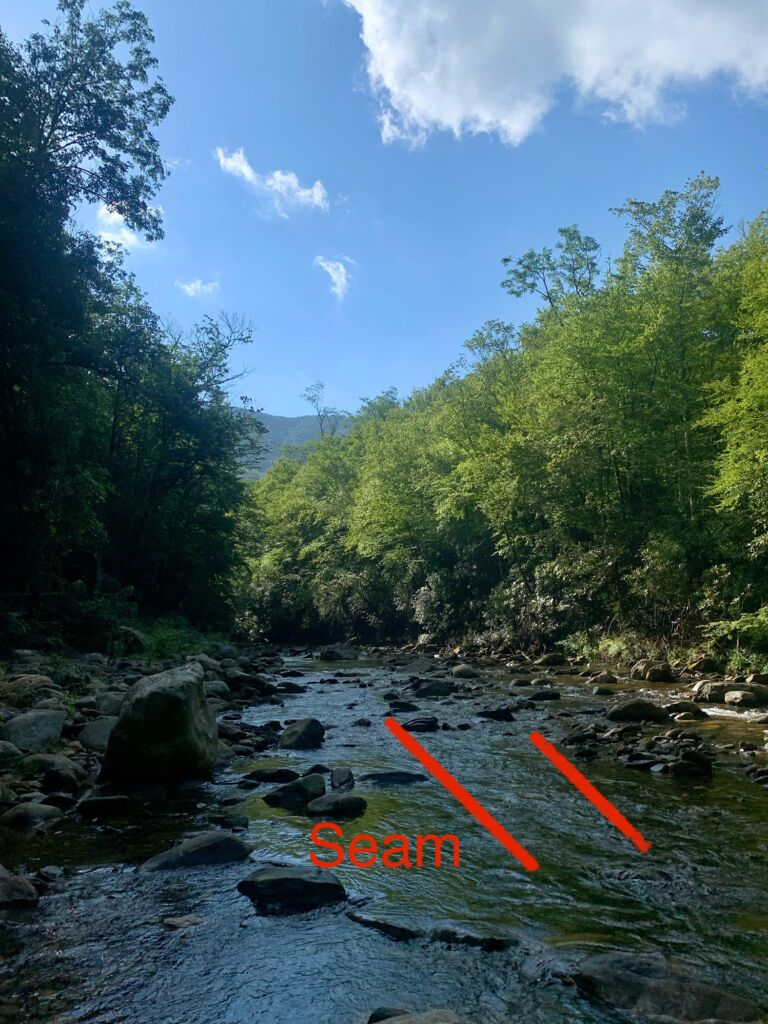
Lakes and ponds offer a vastly different trout fishing experience than that of a river. Larger lakes often need to be trolled for lake trout, which can grow more than sixty pounds. The more common alpine lake or trout pond can be fished in a variety of ways with fly or spinning fear. In alpine lakes, the fish, which can be just about any species, will cruise the banks, looking for easy terrestrial bugs that fall into the water. In the winter, these same trout are buried under two feet of ice, and it is nearly impossible to fish if you can even get to the lake. Trout in alpine lakes can be as spooky as the clear. Still, water allows birds to pick off lazy fish more easily. Fly patterns here can be extremely important, though, as catching a fish often relies mostly on the presentation of the fly, lure, or bait. An inline spinner will get hit with some frequency, though these fish are normally cautious and more likely to hit something smaller, like a fly. Most lower-elevation ponds that hold trout are stocked, and these fish are typically easier to catch and will readily take just about anything you put on a hook.
Read also: Unveiling the Secrets of Freshwater Fishing: A Guide to the Best Lures
Fly Fishing Techniques and Tips
Drifting Technique
The best way to fish most types of flies, baits, and lures is what is called drifting. Fly fishing requires a bit more finesse to get the flies where you want them, but spin fishing is quite simple. If you have a bobber rig, simply cast it into a current section, preferably near a seam like I talked about earlier, and let your bobber float down to the end of the run. If there is a fish in the area, this is your best chance of getting a bite.
For an inline spinner or other trout lures like small jerk baits, the best option is to position yourself downstream of the run and cast up, retrieving the same direction as the current. I haven’t found that adding movement to the lure changes the number of bites much, as most of these bites are just reaction strikes. Another interesting technique I’ve seen some people do in North Carolina, where I predominately fish, is simply drifting their spinner. While I haven’t done this myself, the older men I’ve talked to on the river swear by it. All they do is cast the spinner on the opposite side of the current from where they are and keep the line tight while allowing it to drift downstream. It’s definitely an interesting technique and one I’ll need to try next time I spin fish for trout.
Spin Fishing in Lakes
Spin fishing in lakes involves a lot of casting. Typically, the fish density in these lakes is far less than in a river or stream, so you’ll have to make a lot of adjustments, varying your casting location and which water you target. With bait, there is nothing to do but wait, but in different lakes, trout hold in different depths of water and distances from shore, so it is important to try different things until you find what works.
Fly Fishing Basics
Fly fishing is a slightly more complex method to catch trout, though the general idea is the same. Your goal is to make the flies look like they have either fallen into the water and are drifting downstream or are hatching out of the water. Typically, a dead drift with no movement is the best bet, but more complicated techniques involve skating a dry fly across the top of the water to mimic the hatching bugs. However, this is not typically necessary. The method I’ve had the most success with is just casting into the current, allowing a bit of slack in my leader and allowing the flies to drift downstream with no drag.
This will look different depending on whether you have one or two flies; with one, it is much easier to get a good smooth drift. The casting locations don’t change at all, but the drift is almost inevitably better with a single dry fly than with a dropper or double dry rig. With a dropper, the top indicator fly, as it is called, will drag a little bit. This is because water is closer to the bottom, where the lower fly moves slower than water on the surface. This isn’t always a bad thing, but it does usually mean you’ll get fewer bites on the dry fly in a dropper rig than in a normal single dry rig.
Get your personalized fishing map
Answer a quick quiz and get your own personalized fishing map
Bobber/Indicator Rig
When fishing your flies below a bobber or indicator so the fly fishermen don’t yell at me, you want to cast as close to the head of the pool or even above it if the situation allows. This will allow the bottom fly or flies to sink to the stream bottom before getting to the best part of the drift, which is typically a few feet below the top of the hole. I’m not going to get into how to cast with different fly-fishing rigs because that would take longer than I have here, and it’s something that requires practice more than anything else. A good rule of thumb when fly fishing with either a dropper rig or a bobber rig is that if your bottom fly isn’t getting caught on the bottom occasionally, then you aren’t fishing deep enough. Trout typically sits almost on the bottom of the stream because the rocks cause the water to slow down, making it easier for them to hold position.
Trout Fishing Across the Year
Strategies for spin fishing trout set ups in my opinion don’t change much between seasons, the bite will be slower in the winter as the fish’s metabolism slows, but strategies stay the same.
Winter Fishing for Fly Fishing
For fly fishing, though, there is variance in what works best from season to season. Winter is always tough to fish; trout don’t typically feed in water below around forty degrees which means you have to place the flies directly in front of the fish for them to eat. Dry flies are almost always a waste of time from early December to late March in the east and for even longer out West. If you plan to fish during the winter, I would try to plan for the warmest day you can find. The sun has always helped me, as just a few degrees warmer in water temps can make a huge difference.
Fishing Techniques in Winter
I also typically fish slower in the winter, this goes for spin fishing as well, slowing down and covering the deep holes more thoroughly. The shallow riffles and fast runs are less likely to hold fish in the winter though you will find the occasional feeding trout. In general, the best way to fish for trout in the winter is deep and slow, have your flies deep and fish the slower water.
Early Spring Fishing
Early spring before runoff can be very good fishing as bugs start to hatch after being dormant for the winter. This is a great time to throw on a big dry fly and enjoy the topwater eats. As runoff begins, fishing slows down, and the water becomes difficult to fish in.
Summer Fishing
Summer starts what most consider the best fishing of the year, the hot weather means the fish feed more voraciously and on just about whatever they can find. Out West this is the best time to be on the water, but as an East coast fisherman, I think the fall has the best potential.
Read also: Cabo Fishing Seasons: Your Comprehensive Guide
Fall Fishing
Fall in the Appalachians means big browns move upstream to spawn, and the water also cools from the sweltering seventies until late summer. This encourages the fish to get a little bit more excited as most species prepare to spawn. The brook trout take on the most amazing colors you’ve ever seen, and the rainbows become more aggressive. In my opinion, late September to as late as Thanksgiving is the best fishing in the Appalachians. All that said, don’t let the weather stop you from fishing. Some of my best fishing memories had come from when the fish weren’t biting, and I was just hanging out in the woods.
Best Time of Day for Trout Fishing
The best time of day to fish for trout depends on the time of year, the colder temperatures winter brings mean that fishing during the hottest part of the day is your best bet. This is typically from around two to four but can vary based on your location. Summer is the opposite and often fish are biting the most during the cooler parts of the day. Early mornings can be good, but the best fishing I’ve had in the summer is between nine and noon.
Spring and fall are similarly hard to read. In my experience, fish bite all the time in these seasons. Coming out of winter, they are all hungry and feed readily throughout the day, though, like winter, targeting the warmer parts of the day will yield slightly better results. Fall is similar as the fish are always feeding, it seems; I haven’t really seen a difference between times of day in my fall fishing days. Even if your time of day is not ideal, though, still go as it is possible to catch fish regardless.
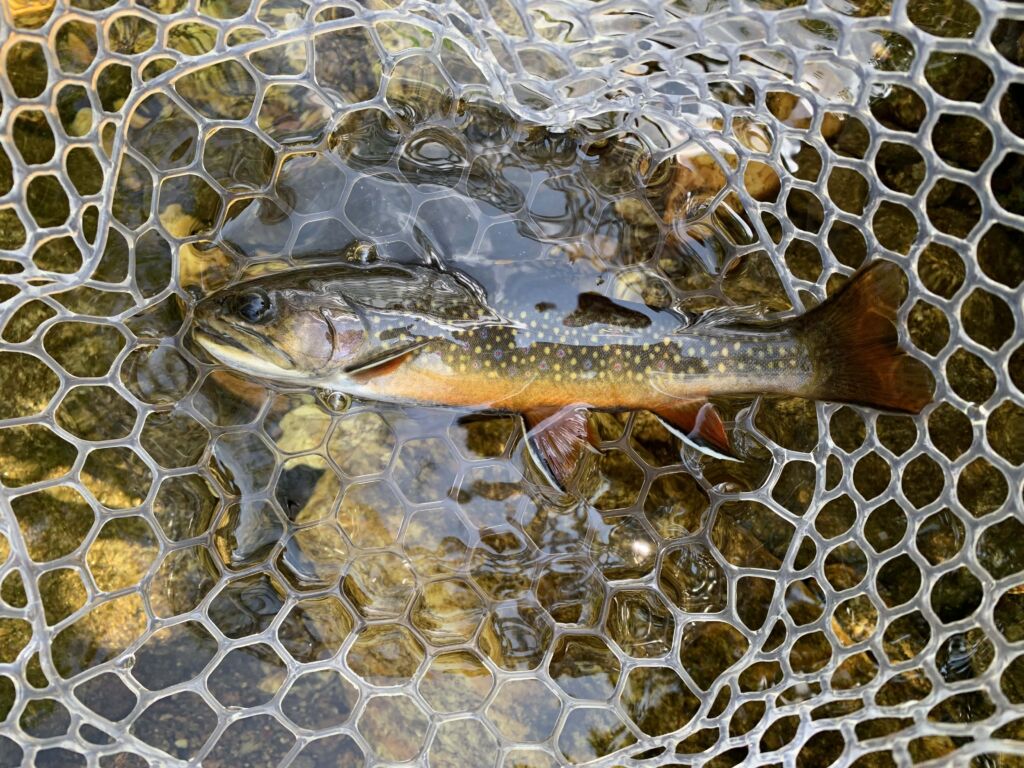
Conclusion: The Ultimate Guide to Setting Up Your Trout Fishing Rig
Trout fishing in any form, whether it be fly or conventional, is one of the most rewarding types of freshwater fishing. To protect the fisheries that hold these esteemed fish, it is necessary to follow regulations for the area you are fishing. Before going, check the regulations for the lake, stream, or river you are planning to fish, these often include single barbless hook restrictions and catch-and-release only to protect some of the more pressured fishing areas.
Get your personalized fishing map
Answer a quick quiz and get your own personalized fishing map
That done, get out and enjoy the water. The rig you use is always less important than the presentation you, as the fisherman, give when fishing for trout. Grab a light rod, maybe a fly rod, and cast at every piece of water you come across. Trout aren’t picky, but they are spooky. Be careful when approaching a hole, run, or bank to ensure you don’t spook the fish before you get a chance to cast at them. Remember that practice is the most important piece of any kind of fishing, and as you hone your trout skills, more and bigger fish will come.
Photo Source: All photos in this article were provided by expert Pierce Latta.
Visit his Instagram profile.
Subscribe to his YouTube channel.
